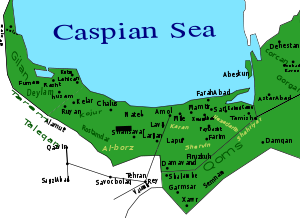Təbəristan
Təbəristan (maz. طبرسّون-تپورسّون) — təxminən İranın Əlburz sıra dağlarının şimal və cənub yamaclarında, Xəzər dənizinin cənub sahillərində yerləşən keçmiş tarixi regionun adıdır. Region, təxminən İranın müasir Mazandaran ostanı, Gülüstan ostanı və Simnan ostanının şimal hissəsinə uyğundur.


Tapurilər və ya Tapirilər[1] Ptolemey və Arrianın qeyd etdiyi Xəzər dənizinin cənubundakı Midiyada bir tayfa idi .[2] Ctesias iki Kadusilər və Hyrcanilər torpaqları arasındakı Tapuri torpağına aiddir.[3]
Tapurilərin adı və ehtimal olunan yaşayış yerləri tarixin müxtəlif dövrlərində Ermənistandan Oksusun şərq tərəfinə qədər ölkənin geniş ərazisi boyunca yayıldığı görünür. Strabon onları Xəzər Qapıları və Raqanın yanında, Parfiyada və ya Derbices və Hyrcani arasında və ya Amardi və digər insanlarla birlikdə Xəzərin cənub sahillərində yerləşdirir; hansı sonuncu baxışda Kurtius, Dionysius və Pliny üst-üstə düşə bilər. Ptolemey bir yerdə onları Midiya qəbilələri hesab edir, , başqa yerdə isə onları Margiana ilə əlaqələndirir. Onların adı müxtəlif müəlliflərdə müəyyən fərqlərlə yazılmışdır; beləliklə, Τάπουροι və Τάπυροι Strabonda baş verir; Pliny və Curtiusda Tapuri; Stephdə Τάπυρροι. B. sub voce Şübhə yoxdur ki, indiki Təbəristan rayonu öz adını onlardan alır. Aelian Midiyada yaşayan Tapurilərin özünəməxsus təsvirini verir.[4]
Mənbə
redaktə- MUHAMMAD B. AL-HASAN B. ISFANDIYÁR, HISTORY OF Tabaristan Arxivləşdirilib 2016-03-03 at the Wayback Machine
- Arxivləşdirilib 2022-03-03 at perseus.tufts.edu [Error: unknown archive URL]
Həmçinin bax
redaktə- ↑ Tapuri. The mountains inland from the coast of Hyrcania are called the "Tapurian mountains" by Arrian, after the people there, settled in the mountains between the Derbices and the Hyrcanii (Str., 11.9.1, 11.11.8). They are spread toward the Caspian Gates and Rhaga in Media (Ptol., 6.2.6). These western Tapuri could have resulted from a tribal division north of the Sarnius/Atrak river—another, perhaps ancestral, group, the Tapurei, is located by Ptolemy (6.14.12) in Scythia. The remainder moved south and east into Margiana ("between the Hyrcani and the Arii," Str., 11.8.8; Ptol., 6.10.2) along the Ochus/Arius (mod. Tejen/Hari-rud) river into Aria (cf. Polyb., 10.49). The Tapuri on the Caspian could, alternatively, represent a later westward migration along the main east-west highway from Margiana. These Tapuri furnished 1,000 cavalry for the battle of Gaugamela (Curt., 3.2.7), apparently aligned with the Hyrcanii (the "Topeiri," Arr., An. 3.8.4). Alexander later subdued them (Arr., An. 3.23.1–2; Polyb., 5.44.5; Curt., 6.4.24–25). A separate satrap administered them at the time of Alexander’s arrival, and this official was assigned the Caspian Mardi as well (Arr., An. 3.22.7, 24.3; 4.18.2). Arxivləşdirilib 2020-12-04 at the Wayback Machine, IRANICAONlINE IRAN v. PEOPLES OF IRAN (2) Pre-Islamic
- ↑ Şablon:Lien web
- ↑ Of the lands which lie on the sea and of the others which border on these, Ninus subdued Egypt and Phoenicia, then Coele-Syria, Cilicia, Pamphylia, and Lycia, and also Caria, Phrygia, and Lydia; moreover, he brought under his sway the Troad, Phrygia on the Hellespont, Propontis, Bithynia, Cappadocia, and all the barbarian nations who inhabit the shores of the Pontus as far as the Tanais; he also made himself lord of the lands of the Cadusii, Tapyri, Hyrcanii, Drangi, of the Derbici, Carmanii, Choromnaei, and of the Borcanii, and Parthyaei; and he invaded both Persis and Susiana and Caspiana, as it is called, which is entered by exceedingly narrow passes, known for that reason as the Caspian Gates. 4 Many other lesser nations he also brought under his rule, about whom it would be a long task to speak. But since Bactriana was difficult to invade and contained multitudes of warlike men, after much toil and labour in vain he deferred to a later time the war against the Bactriani, and leading his forces back into Assyria selected a place excellently situated for the founding of a great city.. Diodorus Siculus, Library 1–7 (2.2.3)
- ↑ Şablon:Lien web